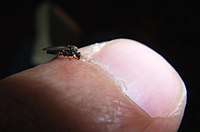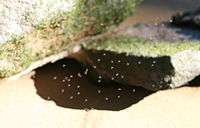Sandfly
Sandfly (or sand fly) is a colloquial name for any species or genus of flying, biting, blood-sucking dipteran (fly) encountered in sandy areas. In the United States, sandfly may refer to certain horse flies that are also known as "greenheads" (family Tabanidae), or to members of the family Ceratopogonidae, also known in Florida and elsewhere as a sand gnat, sandflea, no-see-um (no-see-em, noseeum), granny nipper, chitra, punkie, or punky. Outside the United States, sandfly may refer to members of the subfamily Phlebotominae within the Psychodidae. Biting midges (Ceratopogonidae) are sometimes called sand flies or no-see-ums (no-see-em, noseeum). New Zealand sandflies are in the genus Austrosimulium, a type of black fly.[1]
In the various sorts of sandfly only the female is responsible for biting and sucking the blood of mammals, reptiles and birds; the protein in the blood is necessary for the production of eggs, making the sandfly an anautogenous reproducer.
Some sandfly genera of the subfamily Phlebotominae are the primary vectors of leishmaniasis and pappataci fever; both diseases are confusingly referred to as sandfly fever. In the New World, leishmaniasis is spread by sand flies of the genus Lutzomyia; in the Old World, the disease is spread by sandflies of the genus Phlebotomus. Belize and Honduras are notorious in the Caribbean for their sandfly populations and travel pages frequently warn tourists to bring bug spray containing high concentrations of DEET.
 Indonesian sandfly bites on leg
Indonesian sandfly bites on leg New Zealand Sandfly biting a human's thumb
New Zealand Sandfly biting a human's thumb- Sandfly bite
 A swarm of sandflies at Georges River National Park (Australia)
A swarm of sandflies at Georges River National Park (Australia)
Viruses
Among the viruses that sandflies can carry is the Chandipura virus, which, as a cousin of rabies, is very deadly. There was an outbreak in India in 2010.
Protozoa

Leishmaniasis, a disease caused by several species of the genus Leishmania, is transmitted by various sandflies.[2]
Leishmania donovani causes spiking fevers, hepatosplenomegaly, and pancytopenia. It can be diagnosed though microscopic review by visualizing amastigotes in containing macrophages, and is treatable with sodium stibogluconate.
Prevention
Over-the-counter repellents with high concentrations of DEET or picaridin are proven to work, but may not be suitable for some people, e.g. people with sensitive skin and pregnant women. However, the effectiveness of DEET and picaridin products seems to differ among individuals with some people reporting better results with one product over another while other people finding neither product effective for them. This may be partially due to various species living in different areas.
A particular extract of Lemon Eucalyptus oil (not the essential oil) has now been shown to be as effective as DEET in various studies.[3][4]
Most information on repellents focuses on mosquitoes, but mosquito repellents are effective for sandflies and midges as well.[5]
Cultural views
New Zealand sandflies (which are taxonomically blackflies—Simulidae) have a native Māori legend wherein "the god Tu-te-raki-whanoa had just finished creating the landscape of Fiordland, it was absolutely stunning... so stunning that it stopped people from working. They just stood around gazing at the beauty instead. The goddess Hine-nui-te-pō became angry at these unproductive people, so she created the sandfly to bite them and get them moving".[6]
These sand flies were able, according to another Māori legend, to revive the dead hero Ha-tupatu.[7]
References
- ↑ Sandflies and mosquitoes – Sandflies: New Zealand’s blackflies. Te Ara - the Encyclopedia of New Zealand (2009-03-01). Retrieved on 2011-06-15.
- 1 2 Aoun, K.; Bouratbine, A. (2014). "Cutaneous Leishmaniasis in North Africa: a review". Parasite. 21: 14. doi:10.1051/parasite/2014014. PMC 3952656. PMID 24626301.
- ↑ Trigg, JK (1996). "Evaluation of a eucalyptus-based repellent against Culicoides impunctatus (Diptera:Ceratopogonidae) in Scotland". Journal of the American Mosquito Control Association. 12 (2 Pt 1): 329–30. PMID 8827615.
- ↑ Carroll, SP; Loye, J (2006). "Field test of a lemon eucalyptus repellent against Leptoconops biting midges". Journal of the American Mosquito Control Association. 22 (3): 483–5. doi:10.2987/8756-971X(2006)22[483:FTOALE]2.0.CO;2. PMID 17067050.
- ↑ Centers for Desease Control and Prevention: CDC: West Nile Virus – Updated Insect Repellent. Cdc.gov, USA (2009-10-13). Retrieved on 2011-06-15.
- ↑ Sandflies – New Zealand – IgoUgo – stomps. IgoUgo (2008-06-04). Retrieved on 2011-06-15.
- ↑ Ha-tupatu and the sand flies. Maori.org.nz. Retrieved on 2011-06-15.
External links
- Sand Flies – Beaufort County Library (via Internet Archive)
- Infectious skin disease found in Texas September 15, 2007 Breaking News – Sandfly may carry parasites that will cause infectious skin disease called leishmaniasis.
- Biting midges and no-see-ums --University of Florida